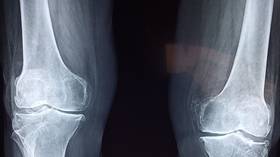It’s going tibia OK: Scientists use NANOTECH to harvest bone-healing stem cells

Boffins at the University of Southampton have developed a technique which sees gold nanoparticles enter human bones and make them glow, helping the scientists find highly prized, bone-healing stem cells.
A cross-disciplinary collaboration between physicists, chemists and tissue engineers, led by Professor of Musculoskeletal Science Richard Oreffo and Professor Antonios Kanaras of the Quantum, Light and Matter Group, is responsible for the potentially revolutionary technique.
They worked together to repurpose nanomaterials to seek out and enrich stem cells located in the human skeleton which could revolutionise treatments for bone injuries and potentially repair or replace lost bones.
Also on rt.com Humans possess genetic blueprints to produce venom, study suggestsThe customised gold nanoparticles, spherical particles made up of thousands of gold atoms, were coated with strands of DNA to make skeletal stem cells in bone marrow glow by releasing a fluorescent dye.
Once glowing, the researchers could then target and isolate them for enrichment therapy, which is between 50 and 500 times more effective than currently available therapies.
The stem cells are then separated using Fluorescence Activated Cell Sorting (FACS) a highly sophisticated and painstaking method.
These bone cells have yet to be encoded for a specific function, and can therefore be repurposed to grow and reform bone and cartilage tissue with a view to mending broken or fractured bones.
Oreffo has been developing bone stem cell-based therapies for over 15 years, while Kanaras and his team have been pioneering novel nano materials for both the biomedical and energy industries for many years.
Also on rt.com Scientists observe ‘quantum sense’ which may EXPLAIN HOW animals ‘see’ magnetic fields for first timeThe development could not have come at a better time, as many nations around the world are witnessing an aging population, with an estimated one in three women and one in five men at risk of osteoporotic fractures globally. Reports suggest that bone fractures alone may cost the European economy €17 billion and the US economy $20 billion each year.
“Identification of unique markers is the holy grail in bone stem cell biology and, while we still have some way to go; these studies offer a step change in our ability to target and identify human bone stem cells and the exciting therapeutic potential therein,” Oreffo said.
The team is currently working on refining their techniques and assessing the potential future applications of their approach before moving to clinical trials with a view to producing proof of concept studies.
Think your friends would be interested? Share this story!














